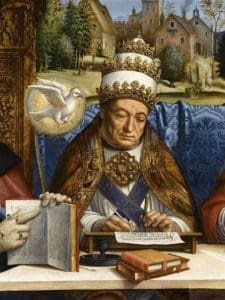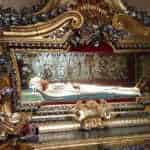Viterbo, Italy: Birthplace of the Conclave….The Palace of the Popes and Body of Saint Rose of Viterbo
The Catholic history of Viterbo:
Located about 40 miles north of Rome, the city of Viterbo played an important role in the Church during the 13th Century. It was home for Popes at one time and the Papal Palace still remains as an attraction in the city. During the period from 1261-1281 the Popes resided here as Rome had become too unstable due to warring factions.
In fact, 7 Popes lived here, and five were elected here during this period.
In addition, it is the birthplace and burial place of Saint Rose of Viterbo.
About the Papal Palace in Veterbo:
It was here that the concept of the Conclave to elect a new Pope began in a rather bizarre fashion. What we take for granted today, was not the same as in the 13th century. The practice at the time was to elect a new Pope in the same place where the old Pope died.

After Pope Clement IV died in 1268, the cardinals meeting in Viterbo could not agree on his successor and, in fact, several cardinal electors died during this period. Time went on, and after 33 months, city officials finally lost patience and locked all of the cardinals in the meeting room. They further escalated the situation by reducing their food to bread and water, and when that still did not work, as a final step they took the roof off the meeting hall, which finally resulted in the election of Pope Gregory X.
And it was Pope Gregory X who instituted the conclave as a way of electing Popes in the future, a word that means “under lock and key“. Pope Benedict XVI paid a visit here in 2009.
The Papal Palace is naturally one of the main attractions in the town. Parts of it are open to the public, and tours are available for both individuals and groups. You can find their official website here.
Viterbo became the final resting place of 5 Popes. Pope Clement IV and Pope Adrian V are entombed in the Church of San Francesco, each on either side of the main altar.
Another Pope, John XXI, is buried in the Cathedral, adjacent to the Papal Palace. The fifth Pope, Alexander IV was buried here, but his tomb was subsequently destroyed.
About Saint Rose of Viterbo:
Rose Venerini was born at Viterbo in Italy in 1656, the daughter of a doctor. Her fiance died before they could get married, and she entered a convent, but then shorty after that returned home to care for her newly widowed mother. Meanwhile, Rose invited the women of the neighborhood to recite the rosary in her home, forming a sort of sodality with them. She became sure that she was called to be in the world as a teacher rather than a contemplative nun in a convent. She was a great teacher and opened a school for girls in 1685.
She was invited her to oversee the training of teachers and the administration of schools by the Bishop of the Diocese of Montefiascone. As Rose’s reputation grew, she was called upon to organize schools in many parts of Italy, including Rome. Her disposition was right for the task as well, for Rose often met considerable opposition but was never deterred. The sodality, or group of women she had invited to prayer, was ultimately given the rank of a religious congregation. Today, the so-called Venerini Sisters can be found in the United States and elsewhere, working among Italian immigrants.
She died in Rome in 1728, where a number of miracles were attributed to her. She was beatified in 1952 and canonized in 2006. The group of women she had invited to prayer ultimately became a religious congregation. Today, the so-called Venerini Sisters can be found in the United States and elsewhere, working among Italian immigrants.
Through all of this she was an ardent support of the Papacy at a time when it was under threat. Her loyalty resulted in the family being exiled from the city until the Pope’s side one and they returned. She is credited with the gift of prophecy: on December 5, 1250 she foretold the death of the emperor, which took place just one week later.

There is some debate over whether it is incorrupt or mummified since the monks placed her body in a glass case soon after her death.
The Festival of Saint Rose of Viterbo is celebrated on the evening of September 3rd and is celebrated with a procession through the town with a statue of the Saint on top of a tower almost 90 feet tall carried by about 100 volunteers. Her feast day is the following day, September 4th.
For an interesting view of the celebration click here.
Traveling to Viterbo:
Viterbo is located about 60 miles north of Rome and can be reached by train on direct lines taking around 2 hours. Both the Palace of the Popes and the Cathedral are near the city center.
The city is served by two train stations, Porta Fiorentina & Viterbo Porto Romano. The former is closer to the center of the city although neither one is far from the center. Get train & bus schedules, see fares & buy tickets here
Click here for a website about the town of Viterbo and the Palace of the Popes
Back to Catholic shrines & places of interest in Italy
Sources:
1. Catholic Encyclopedia
2. Catholic News Service, July 30, 2009
3. Photo courtesy Wikimedia

